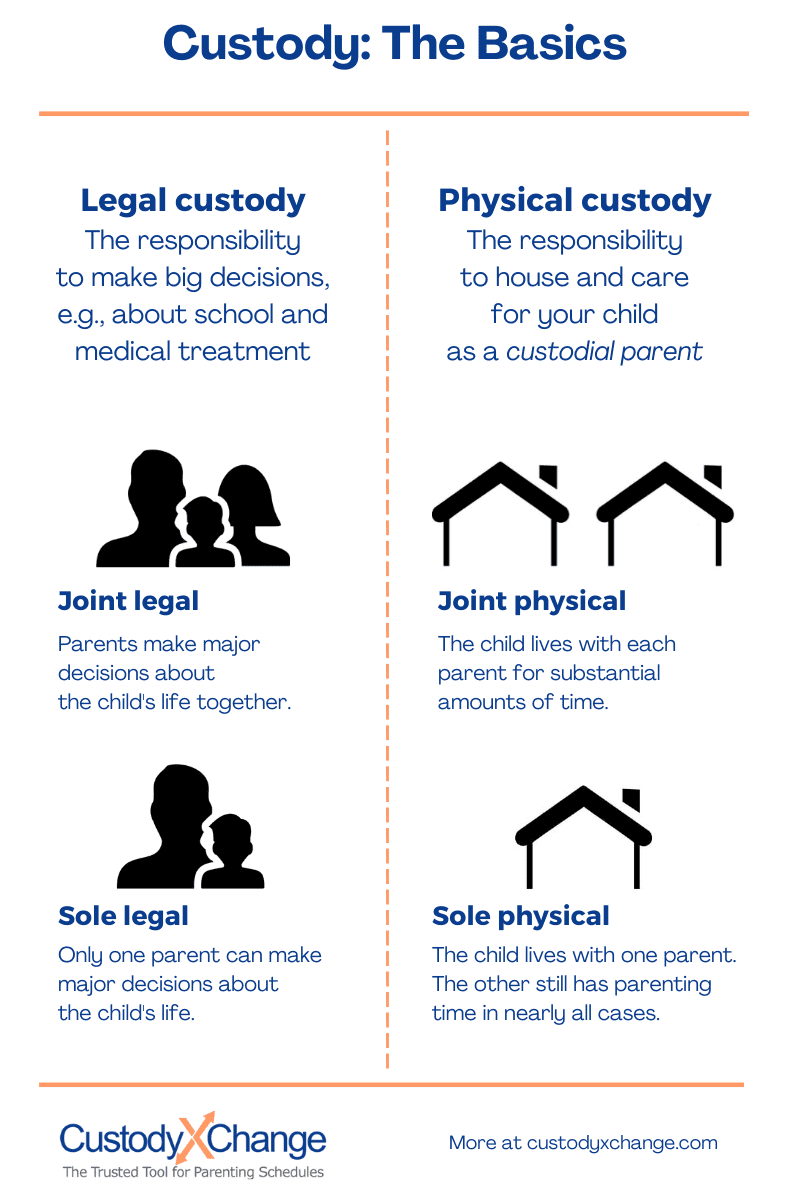Types of Custody: Full, Sole, Primary, Joint & More
There are many types of custody. The terminology varies by state, which can make researching custody arrangements difficult. However, many terms are common across states.
You might hear the word custody in reference to the police taking detaining someone, but here we're discussing child custody.
It's essential that you know the different types of custody before going to court so you know what to ask for. With this information, you can prepare a court-ready proposal or agreement that suits the best interests of your child.

You can customize this to fit your situation with Custody X Change.
Legal custody versus physical custody
Every child custody case deals with these two types of custody, although your location might use slightly different terms for them.
First, legal custody is the right and responsibility to make decisions about the child's schooling, medical care, religion, etc. There are two types of legal custody.
- Sole legal custody allows one parent to make all the major decisions.
- Joint legal custody gives both parents decision-making authority.
Second, physical custody defines where the child lives. There are two types of physical custody as well.
- Sole physical custody places the child with the custodial parent for all or most of the time. The noncustodial parent may have limited visits or none at all.
- Joint physical custody means the child lives with both parents for equal or near-equal time.
You could have one type of legal custody yet another type of physical custody. For example, parents could have joint legal custody even if one parent has sole physical custody.
Sole custody versus joint custody
When people say sole custody, they usually mean that one parent (the custodial parent) has all or the majority of parenting time, plus all the parental rights and responsibilities. It is typically only awarded when one parent is unfit.
Fighting for sole custody isn't always the best idea. You should only consider it if it's dangerous for your child to be around the other parent.
When you hear joint custody casually, it typically means the child splits their time between both parent's homes and both parents have decision-making power. While it's considered the best arrangement for a child's emotional health in most cases, there are pros and cons to joint custody.
Other terms you might hear
Governments each use different terms to describe child custody arrangements, and lately many have moved toward more conversational language. In addition, many unofficial terms are common among parents. All this leads to a plethora of names for parenting arrangements. Here are some you might come across.
Full custody
Full custody is a term often used interchangeably with sole custody, although the latter is the more legally acceptable term. Both give one parent all or the majority of parenting time and all the legal custody.
Shared custody
This is a synonym for joint custody, in which parents share time and responsibilities. Check which term your court prefers.
Primary custody
Primary custody gives one parent the vast majority of parenting time. The other parent gets some visitation time. In states that use this term, like Tennessee, the parent whom the child mostly lives with is often called the primary residential custodian or primary residential parent.
Partial custody
Partial custody is essentially primary custody from the nonprimary parent's point of view. In primary custody, the parent with less parenting time is said to have partial custody.
Split custody
Split custody allows parents with multiple children to each provide the primary residence for at least one child. For example, one parent could have sole (or primary) physical custody of Anna and Sebastian, and the other might have sole (or primary) physical custody of Esther.
This is the rarest type of custody as a court is more likely to award joint custody to parents that are both fit to care for their children.
Designating a type of custody in your parenting plan
Designating custody in your parenting plan is easy if you use the Custody X Change app.
Click the "parenting plan" tab. More than 25 categories of parenting provisions will appear.

You can customize this to fit your situation with Custody X Change.
Click the custody categories, and select the type of custody you want to assign.
Now you're on your way to a professional-quality document for managing custody of your child.

You can customize this to fit your situation with Custody X Change.
